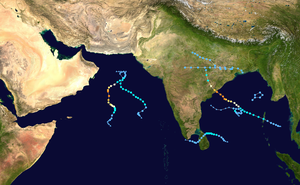Cyclone Hudhud
Extremely Severe Cyclonic Storm Hudhud[nb 1] was a strong tropical cyclone that caused extensive damage and loss of life in eastern India and Nepal during October 2014. Hudhud originated from a low pressure system that formed under the influence of an upper-air cyclonic circulation in the Andaman Sea on October 6. Hudhud intensified into a cyclonic storm on October 8 and as a Severe Cyclonic Storm on October 9. Hudhud underwent rapid deepening in the following days and was classified as a Very Severe Cyclonic Storm by the IMD. Shortly before landfall near Visakhapatnam, Andhra Pradesh, on October 12, Hudhud reached its peak strength with three-minute wind speeds of 185 km/h (115 mph) and a minimum central pressure of 960 mbar (28.35 inHg). The system then drifted northwards towards Uttar Pradesh and Nepal, causing widespread rains in both areas and heavy snowfall in the latter.
| Extremely severe cyclonic storm (IMD scale) | |
|---|---|
| Category 4 tropical cyclone (SSHWS) | |
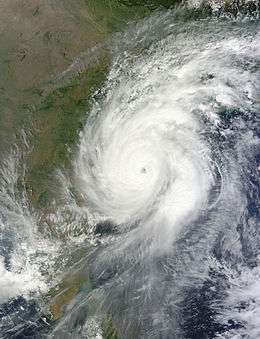 Hudhud nearing landfall at peak strength on October 12, 2014 | |
| Formed | October 7, 2014 |
| Dissipated | October 14, 2014 |
| Highest winds | 3-minute sustained: 185 km/h (115 mph) 1-minute sustained: 215 km/h (130 mph) Gusts: 260 km/h (160 mph) |
| Lowest pressure | 950 hPa (mbar); 28.05 inHg |
| Fatalities | 124 total |
| Damage | $3.58 billion (2014 USD) |
| Areas affected | |
| Part of the 2014 North Indian Ocean cyclone season | |
Hudhud caused extensive damage to the city of Visakhapatnam and the neighbouring districts of Vizianagaram and Srikakulam of Andhra Pradesh. Damages were estimated to be ₹219 billion (US$3.58 billion) by the Andhra state government.[3] At least 124 deaths have been confirmed, a majority of them from Andhra Pradesh and Nepal, with the latter experiencing an avalanche due to the cyclone.
Meteorological history
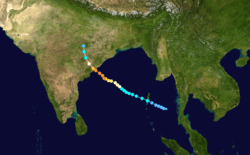
Under the influence of an upper-air cyclonic circulation, a low-pressure area formed over the Andaman Sea on October 6.[4] It slowly consolidated and was upgraded to a depression by the India Meteorological Department (IMD) on October 7. While over open waters, the depression continued to encounter a favorable environment, and a tropical cyclone formation alert (TCFA) was issued by the Joint Typhoon Warning Center (JTWC), followed by IMD upgrading the storm into a deep depression.[5][6]
In the early hours of October 8, the JTWC started issuing its advisories for the system as it recorded tropical storm winds at the storm's centre.[7] The IMD later reported that the deep depression made its first landfall over Long Island, Andaman, and had reached cyclonic storm intensity, naming it Hudhud.[8] After entering the Bay of Bengal, Hudhud continued to intensify the following day, and was upgraded to a severe cyclonic storm.
Early on October 10, the JTWC classified the storm as a Category 1 tropical cyclone after it formed a microwave eye feature and was located in an environment favorable for further intensification with moderate wind shear.[9] The IMD upgraded Hudhud to a very severe cyclonic storm later the same day, and the JTWC further upgraded the storm to a Category 2 tropical cyclone.[10]
On October 11, Hudhud underwent rapid intensification and developed an eye at its center. In the following hours, the storm reached its peak intensity with a minimum central pressure of 950 mbar (28.05 inHg) and three-minute average windspeeds of 185 km/h (115 mph). Maintaining intensity, it made landfall over Visakhapatnam, Andhra Pradesh at noon of October 12, near 17.7°N 83.3°E. The maximum wind gust recorded by the High Wind Speed Recorder (HWSR) instrument of the Cyclone Warning Center in Visakhapatnam was 260 km/h (160 mph). Measured by the Doppler weather radar stationed in the city, the storm's eye was 66 km (41 mi) in diameter. The strength of the winds disrupted telecommunication lines and damaged the radar, inhibiting further observations.[11]
Bringing extensive damage to the coastal districts of Andhra Pradesh, Hudhud gradually weakened as it curved northwards over land. The storm continued its weakening trend and was last noted as a well-marked low pressure area over east Uttar Pradesh on October 14.[12] Unlike most BoB storms that dissipate quickly over land, Hudhud has been the only TC whose remnant ever reached as far north as the Himalayas.[13]
Preparations and impact
India
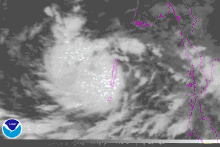
In light of the storm, the National Disaster Response Force (NDRF) mobilized 35 teams in Andhra Pradesh and Odisha.[14] The East Coast Railway cancelled 38 trains on October 12 when the cyclone made landfall.[15][16]
Andaman and Nicobar Islands
On October 8, while Hudhud was gaining cyclonic storm intensity, the authorities closed schools and cancelled ferry services in and around the Andaman Islands.Local fishermen were warned about the storm. The Andaman Trunk Road, one of the major roads traversing the island, was shut down after trees were uprooted due to the storm's force. Landslides were reported on the island, causing some power and communication lines to fail.[17]
Andhra Pradesh
An alert was sounded in nine out of thirteen districts of Andhra Pradesh where standing crops including paddy, groundnut, sugarcane, and pulses were yet to be harvested. Over 700,000 people, including 500,000 people in Andhra Pradesh, were evacuated and put up in relief camps & emergency bunkers. The local government made arrangements to shift half a million people in all.[18][19]
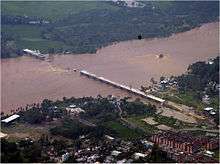
Hudhud crossed the coast of Andhra Pradesh at the noon of October 12 over Visakhapatnam,[20] with winds exceeding 185 km/h (115 mph). As per initial reports, 3 people were killed due to heavy rainfall accompanied by strong winds in coastal areas.[21] Within hours of hitting the coast, the cyclone severed the radar link of Visakhapatnam Cyclone Warning Centre.[22]
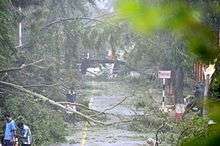
Visakhapatnam, also known as Vizag, bore the brunt of Hudhud, which hit its coast with a speed of 185 km/h (115 mph). Hundreds of vehicles parked on roads were damaged while heavy rains inundated a few colonies.[23] The runway at Visakhapatnam Airport was flooded and the radar and navigational aids were destroyed. The roof of the terminal was torn apart due to the speed of the cyclone.[24] Villages near Vizag were also significantly affected by Hudhud, including Kasimkota, which is known for its robust food distribution system during the cyclone that became standard ration procedure for Visakhapatnam disaster management.[25][26]
Hudhud caused 61 deaths within Andhra Pradesh and an estimated damage of ₹219 billion (US$3.58 billion), including the industrial damage of ₹61.36 billion (US$1 billion).[3]
Odisha
The Odisha government had placed 16 districts under high alert: Balasore, Kendrapara, Bhadrak, Jagatsinghpur, Puri, Ganjam, Mayurbhanj, Jajpur, Cuttack, Khurdha, Nayagarh, Gajapati, Dhenkanal, Keonjhar, Malkangiri and Koraput.
At the time of the storm landfall, strong winds and heavy rainfall commenced in southern Odisha districts, leading to disruption in power supply. Wind speeds reaching 90 km/h (56 mph) were predicted in the region.[27] 2 people were killed in Odisha.[28]Government of Disha Also dispatched 30 team from OSDMA for help in relief and rescue.[29]
Uttar Pradesh
Hudhud killed 18 people in the state.[30]
Aftermath
The Prime Minister of India, Narendra Modi announced on October 15 that ₹1000 crore (US$163 million) was to be awarded as aid for affected areas in Andhra Pradesh.[33] Also, the JK Tyre FMSCI National Karting Championship held by the FMSCI in Vishakapatnam for its final round of the championship had to be postponed.
See also
| Wikimedia Commons has media related to Cyclone Hudhud. |
Notes
References
- "How Cyclone Hudhud got its name". 12 October 2014. Archived from the original on 15 October 2014. Retrieved 12 October 2014.
- Quran 27:20–28
- "Cyclone Hudhud caused Rs 21,908 crore loss, agriculture sector worst hit: Andhra government". Daily News and Analysis. 19 December 2014. Retrieved 6 February 2015.
- "Tropical Weather Outlook for North Indian Ocean Issued at 0600 UTC of October 6, 2014" (PDF). India Meteorological Department. Archived from the original (PDF) on October 7, 2014. Retrieved 7 October 2014.
- "Tropical Cyclone Formation Alert – Issued at 1330 UTC, 7 October 2014". Joint Typhoon Warning Center. Archived from the original on October 10, 2014. Retrieved 10 October 2014.
- "Tropical Weather Outlook for North Indian Ocean Issued at 0600 UTC of October 7, 2014" (PDF). India Meteorological Department. Archived from the original (PDF) on October 7, 2014. Retrieved 7 October 2014.
- "Tropical Cyclone 03B (Three) Warning #01 Issued at 0300 UTC of October 8, 2014". Joint Typhoon Warning Center. Archived from the original on October 8, 2014. Retrieved 8 October 2014.
- "Cyclonic Storm Hudhud over north Andaman Sea & adjoining southeast Bay of Bengal" (PDF). India Meteorological Department. Archived from the original (PDF) on October 8, 2014. Retrieved 8 October 2014.
- "Tropical Cyclone 03B (Hudhud) Warning #09 Issue at 10 October 2013, 0300 UTC". Joint Typhoon Warning Center. Archived from the original on October 10, 2014. Retrieved 10 October 2014.
- "Tropical Cyclone 03B Best Track as on 10 October 2014". Joint Typhoon Warning Center. Archived from the original on October 10, 2014. Retrieved 10 October 2014.
- "Very Severe Cyclonic Storm, HUDHUD over the Bay of Bengal (7-14 October 2014): A Report" (PDF). India Meteorological Department. Archived from the original (PDF) on November 6, 2014. Retrieved 6 November 2014.
- "BOB 03 Advisory 54 issued at 1300 UTC, October 14, 2014" (PDF). India Meteorological Department. Archived from the original (PDF) on October 15, 2014. Retrieved 15 October 2014.
- Wang, S-Y, Simon; Gillies, Robert R; Fosu, Boniface; Singh, Pratibha M (December 2015). "The Deadly Himalayan Snowstorm of October 2014: Synoptic Conditions and Associated Trends [in "Explaining Extremes of 2014 from a Climate Perspective"]". Bulletin of the American Meteorological Society. 96 (12): S89–S94. Bibcode:2015BAMS...96S..89S. doi:10.1175/BAMS-D-15-00113.1.CS1 maint: multiple names: authors list (link)
- "Hudhud intensifies: Andhra Pradesh, Odisha on high alert". India Today. India Today. Retrieved 10 October 2014.
- "BULLETIN No.4 Trains Cancelled / Diverted / Partially Cancelled on account of Cyclone 'Hudhud'". 10 October 2014. Retrieved 11 October 2014.
- "Cyclone Hudhud Effect: 38 Trains Cancelled on October 12". 11 October 2014. Retrieved 11 October 2014.
- "Cyclone Hudhud Heads for Odisha, After Battering Andaman and Nicobar Islands". NDTV. 8 October 2014. Retrieved 12 October 2014.
- "Cyclone Hudhud: 1.11 lakh people in Andhra Pradesh evacuated". Retrieved 11 October 2014.
- "Cyclone Hudhud: PM Narendra Modi to visit Visakhapatnam today, take stock of situation". Retrieved 13 October 2014.
- "Hudhud Cyclone Date – Anniversary observed in Vizag". TSAPRoundup. IANS. 12 October 2015. Archived from the original on 14 October 2015. Retrieved 12 October 2015.
- "3 killed as cyclone Hudhud hits coastal Andhra Pradesh". news.biharprabha.com. IANS. 12 October 2014. Retrieved 12 October 2014.
- "Cyclone warning centre at Vizag also hit by Hudhud". news.biharprabha.com. IANS. 12 October 2014. Retrieved 12 October 2014.
- "Relief operations begin in cyclone-hit Andhra". 13 October 2014. Retrieved 13 October 2014.
- "Hudhud rips through Visakhapatnam airport". Times of India. Hyderabad. 14 October 2014. Retrieved Oct 15, 2014.
- "Picking up the pieces in India after Cyclone Hudhud". 22 April 2015. Retrieved 22 April 2015.
- "Kasimkota Hudhud Rehabilitation and Food Distribution Database" (PDF). Visakhapatnam Official Website. National Informatics Centre. Retrieved 10 December 2016.
- "Cyclone Hudhud triggers Heavy rainfall in Southern Odisha". news.biharprabha.com. IANS. 12 October 2014. Retrieved 12 October 2014.
- "Cyclone Hudhud: 2 killed in Odisha, 68,000 people moved to safer places". Times of India. 12 October 2014. Retrieved 12 October 2014.
- Mishra, Ashutosh; Mohanty, Subhashish (2014-10-14). "Odisha returns Andhra's favour". Telegraph India. Retrieved 2019-10-22.
- "Cyclone Hudhud impact: Heavy rain kills 18 in Uttar Pradesh". India Today. 15 October 2014. Retrieved 15 October 2014.
- "Nepal vows new safety rules for trekkers after deaths of 41 killed in blizzard, avalanches". 21 October 2014. Retrieved 22 October 2014.
- "Freak Nepal blizzards kill at least 20, including hikers, guides". 15 October 2014. Retrieved 18 October 2014.
- "Cyclone Hudhud Live: Modi announces Rs 1000 cr-aid,which was never fulfilled; Vishakhapatnam limps back to normalcy". www.firstpost.com. FIRSTPOST. 15 October 2014. Archived from the original on 15 October 2014. Retrieved 15 October 2014.
